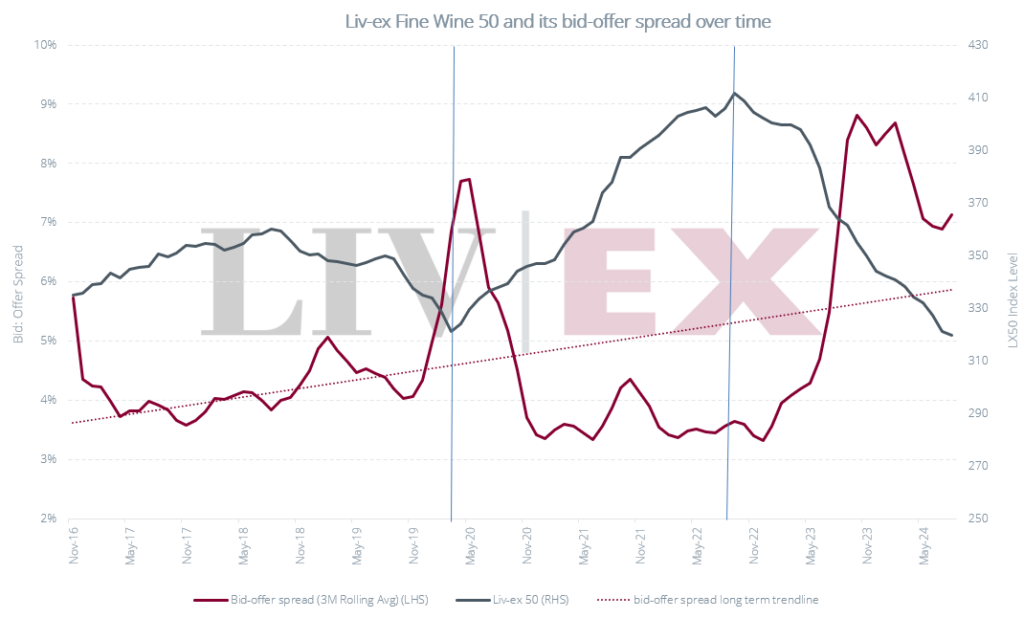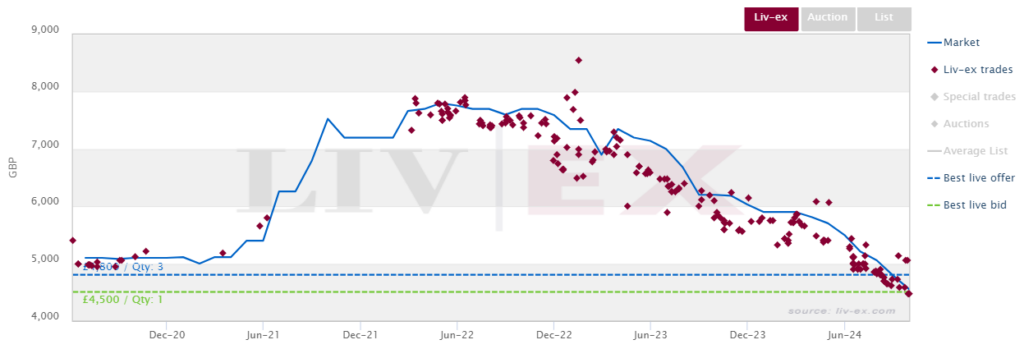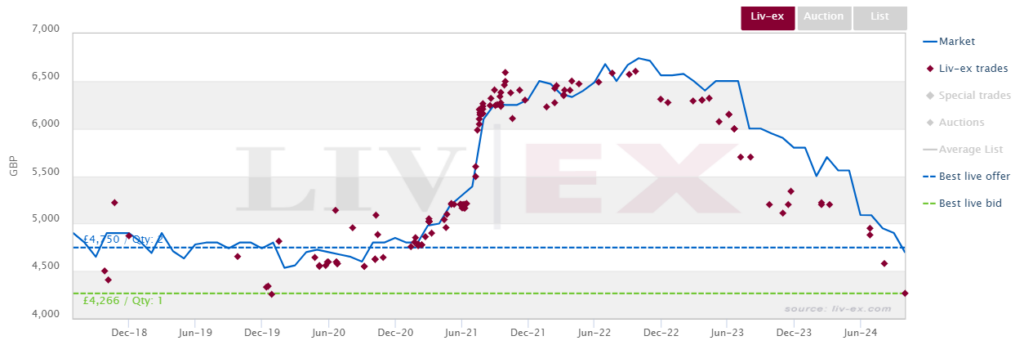What’s happening in the market?
Bordeaux is off to a strong start this week, accounting for 41.2% of traded value since Friday. Château Lafite Rothschild is in the lead as the region’s top-traded producer, with several vintages of both the first and second wine changing hands.
Thanks to trades of high-value wines from Domaine de la Romanée-Conti, Domaine Leflaive and Domaine Leroy, Burgundy has similarly regained some ground on last week.
Tuscany’s trade share, on the other hand, has slipped slightly. Still, Super Tuscans Sassicaia, Masseto and Ornellaia have traded actively.
Today’s deep dive: the Liv-ex Fine Wine 50’s bid-offer spread
In traditional stock markets, the bid-offer spread (the difference between the highest bid and lowest offer) is understood as an indicator of liquidity and demand. A narrow spread generally means a particular stock can be easily converted into cash with minimal risk of moving the market. A widening spread reflects increasing uncertainty about the future direction of the market. Today, charting its bid-offer spread over the past eight years, we consider these assumptions in relation to the Liv-ex Fine Wine 50.
While the Liv-ex Fine Wine 50 exhibits less volatility than its bid-offer spread, the two appear to have a generally inverse relationship. In theory, upward moving markets should be more active, and therefore more liquid and less volatile than downward moving markets. Thus, this relationship should make theoretical sense. Still, there appears to be a spike in the bid-offer spread predating the turn of the market in March 2020.
A wide bid-offer spread can indicate uncertainty about price movements in either direction. If buyers think it is likely that prices will fall, they will lower their bids, while if sellers think prices will rise, they will hold or raise their offers. In both scenarios, the counterparty will be more hesitant to react, thereby widening the spread.
Once the market establishes a steady upward or downward trend, participants can place their bets with greater confidence. Thus, the bid-offer spread narrows. This narrowing, however, is more obvious in an upward moving market. While stock traders are able to protect profit margins during a down market by shorting (placing bets on downward price movement), this is near-impossible in the fine wine market. Instead, in an attempt to protect their margins, merchants widen the spread by keeping their offers high despite falling bids – until the cost of holding the wine is no longer considered a viable option. Merchants can place bets on upward market movement simply by holding onto their stock.
In 2023, the Liv-ex Fine Wine 50’s bid-offer spread widened to an eight-year high but has narrowed since the start of 2024. It would seem that with the dawn of a new year, and with the market off 15% from peak, merchants (and/or their clients) began to consider market entry points, by placing more competitive bids. With no apparent trend reversal in sight and the promise of discounted En Primeur release pricing, sellers likely began to free up capital by moving offers down to meet bids.
Wines with high liquidity provide more stable investment opportunities in a down market. Château Lafite 2019, for example, as the top-traded wine of the year so far, has a much narrower bid-offer spread than the 2017 vintage (5.6% vs. 12.4%). With an abundance of recent trades, both buyers and sellers are more restricted by precedence. As such, narrow bid-offer ratios can mitigate risk, providing buyers with a degree of certainty that their purchases will not quickly lose value.
Liv-ex trades of Château Lafite Rothschild 2019
Liv-ex trades of Château Lafite Rothschild 2017
Liv-ex analysis is drawn from the world’s most comprehensive database of fine wine prices. The data reflects the real time activity of Liv-ex’s 620+ merchant members from across the globe. Together they represent the largest pool of liquidity in the world – currently £100m of bids and offers across 20,000 wines.






